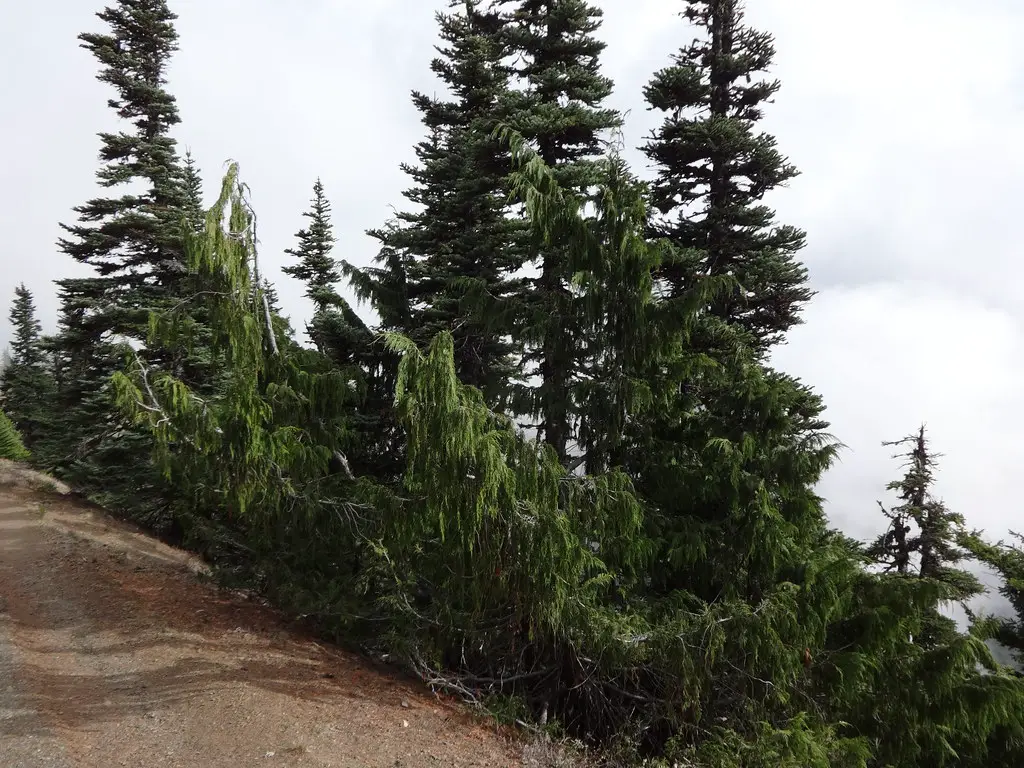The Alaska Cedar, known scientifically as Cupressus nootkatensis, is a remarkable evergreen native to the coastal regions of the Pacific Northwest, extending north into Alaska. Admired for its gracefully drooping branches and unique, flattened sprays of foliage, the Alaska Cedar is a prized addition to landscapes and gardens. The tree often grows near streams or on moist mountainsides and can reach impressive heights in ideal conditions.
Aside from its aesthetic appeal, the Alaska Cedar has been highly valued by indigenous communities. Its flexible wood has been used for making tools, while its bark has been utilized for weaving and its roots for crafting baskets. It’s also known to have traditional medicinal applications.
The Alaska Cedar’s adaptability to a wide range of conditions and resistance to common diseases makes it an excellent choice for various landscapes. Its graceful form and pleasant fragrance add to its desirability, making it a preferred selection among garden enthusiasts and landscape architects.
| Common Names | Alaska Cedar, Nootka Cypress, Yellow Cedar |
|---|---|
| Botanical Name | Cupressus nootkatensis |
| Family | Cupressaceae |
| Plant Type | Evergreen tree |
| Mature Size | 40 to 90 feet tall |
| Sun Exposure | Full sun to partial shade |
| Soil Type | Well-drained, acidic to neutral |
| Hardiness Zones | 4 to 7 |
| Native Area | Pacific Northwest, Alaska |
Alaska Cedar Care
Alaska Cedar requires minimal care, making it suitable for both novice and expert gardeners. It thrives in well-drained soils and appreciates consistent moisture, particularly during its formative years. Planting in a location protected from harsh winds and providing regular mulching can help maintain soil moisture and temperature.
Pruning is not often required, but when needed, it should be done with care to maintain the tree’s natural shape. Monitoring for pests and diseases and promptly treating any infestations will ensure the continued health and beauty of the Alaska Cedar.
Light Requirement for Alaska Cedar
Alaska Cedar grows best in full sun to partial shade. While it can tolerate a range of light conditions, providing ample sunlight encourages healthy growth and full foliage development.
Soil Requirements for Alaska Cedar
Well-drained, acidic to neutral soils are preferred for Alaska Cedar. It can adapt to different soil types, but heavy clay or overly sandy soils should be amended to provide optimal growing conditions.
Water Requirements for Alaska Cedar
Consistent moisture is essential, especially during the tree’s establishment phase. Mature Alaska Cedar can withstand occasional drought but prefers regular watering to maintain its health and appearance.
Temperature and Humidity
Alaska Cedar thrives in hardiness zones 4 to 7 and can tolerate both cold winters and mild summers. It prefers humid environments but can adapt to varying humidity levels with proper care.
Fertilizer
Fertilizing is generally not necessary for Alaska Cedar. If growth seems sluggish, a balanced, slow-release fertilizer can be applied in the spring.
Pruning Alaska Cedar
Pruning is rarely required and should be done minimally to maintain the natural, graceful shape of the tree. Remove dead or damaged branches as needed.
Propagating Alaska Cedar
Propagation is typically achieved through cuttings or seeds. Taking cuttings from healthy branches and rooting them in a well-drained medium can provide new plants.
How To Grow Alaska Cedar From Seed
Growing Alaska Cedar from seed requires patience and proper stratification. Sowing seeds in a well-drained mix, followed by chilling and consistent moisture, will aid in successful germination.
Common Pests & Plant Diseases
Aphids
Aphids may occasionally infest Alaska Cedar, but they are easily controlled with insecticidal soap.
Root Rot
Poorly drained soils can lead to root rot. Planting in well-drained soil and avoiding overwatering can prevent this issue.
Common Problems With Alaska Cedar
Browning Foliage
Browning foliage may indicate overwatering or a lack of nutrients. Adjusting watering and fertilization can alleviate this problem.
Weak Growth
Weak growth may result from poor soil or inadequate sunlight. Amending soil and ensuring proper sunlight can improve growth.
Pro Tips
- Select a well-drained location with access to full sun or partial shade.
- Monitor for pests and diseases and treat promptly if needed.
- Provide consistent moisture during the tree’s establishment phase.
- Appreciate the unique, graceful appearance of Alaska Cedar and avoid excessive pruning.
- Utilize mulch to conserve soil moisture and regulate temperature.




